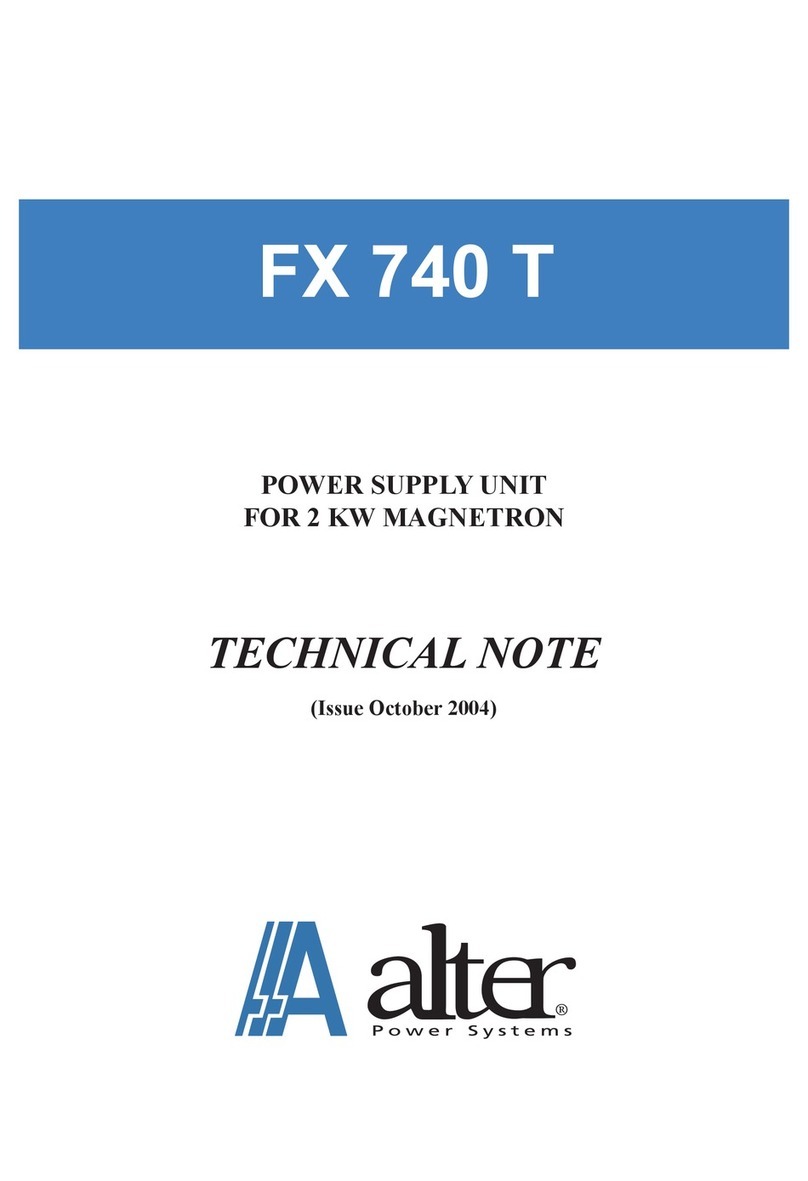Equipment installation
The SM1280x cannot operate on a bench: it must be installed
into a proper cabinet like a commercial 19” standard enclo-
sure.
The equipment is intended for industrial use only, not for
laboratory use, and user must respect the wiring norms and
prescriptions as described into next paragraph (“Wiring
instruction”).
The equipment cannot operate cantilevered, it must be safely
xed inside a cabinet by means of screws on the front panel
(which is provided with 4 holes) and supported by means of a
proper frame on the bottom for, at least, 3/4 of the total depth.
Usually two “L” shaped supports on each side of the equip-
ment, having a dimension of mm 15(h) x 30(l) x 2 (thick) are
suitable for that purpose.
The rear side of the equipment must be protected by a xed
panel which can be removed only by means of tools or by a
door with security micro-switch: when the door is opened the
micro-switch must shut-off the main line. This safety precau-
tions must be taken to avoid operations on rear fuses or on
connectors while the unit is still powered.
Special attention must be taken on designing the cooling air
ow in case of stacking several units into the same cabinet.
Note that each equipment has its own fan which intake approx
200 m³/h: the outlet of the exhaust air is on rear panel, the
inlets on the right side (looking at front).
When designing a board to house several units we recommend
to adopt the following design criteria:
1. use a standard 19” wide enclosure with a depth of 800 mm
(32”);
2. allow free intake of the cooling air from the front of the
cabinet and exhaust air from back panel throu the top of the
cabinet or the back side;
3. in case of ambient air with high degree of dust and moisture,
install a proper air conditioner; if you cannot do this, then you
have to use suitable air lters and instruct the user about their
cleaning;
4. provide a separation between the air intake duct and the air
outlets, in order to avoid air-recyrculating;
Handling instructions
The equipment weight is 35 kg (77 lbs). Always lift from the
bottom and use an adeguate rugged support to avoid personal
injury and damage to equipment itself.
In case of shipping, package with the original package or use
a wooden case and a proper ller: movement of the equipment
inside the package must be avoided.
Warning for handling: use handles only for help during
installation. Never use handles to lift the rack: the handles
don’t withstand the off-center weight of the rack!
To lift always lean the rack over a proper supporting base.
Wiring instructions
The SM1280 must be installed and serviced only by qualied
personnel acquainted with the regulations covering the applica-
tion. For safety operations the following rules must be adopted:
I) The equipment must be grounded through the connector #1
using pin 4 (see the wiring diagram at page 15, 16).
II) Connect the ground screw on panel rear (indicated by
“ground” symbol) directly to the remote microwave generator
head by a separate yellow/green wire gauge 2.5 mm².
III) The main supply must be provided through connector #1:
connect phases according to schematic at page 15 & 16: the
connector’s pins for model T & U can accept wires with gauge
up to 4 mm²; the connector’s pins for model D can accept
wires with gauge up to 10 mm²;
Warning: this connector is not intended for live insertion of
the unit: an external tripolar breaker must always be pro-
vided, and the unit must be switched off before inserting/
unplugging of the connector.
IV) The connector #4, with 14 pins, brings the head’s signals
to the equipment. Use wires with max gauge of 1.5 mm², refer
to wiring diagram at page 17.
V) The connector #5 is the high voltage output and must be
connected to magnetron’s cathode, usually marked with the
symbol “FA” on the magnetron’s teminal. The voltage value is
near -8 kV .Use a proper insulated cable with working voltage
>10 kVdc and minimum gauge of 0.25 mm²; protect the wire
with sheating (armoured if appropriate).
Assemble the wire into plug according to professional rules.
The reliability of the equipment starts from the h.v. connec-
tions.
ALTER may supply the HV cable with lenght on request.
VI) The connector #3 provides the power supply for the
lament transformer (usually located near the magnetron), the
magnetron fan and a warning lamp. Use wires wih max gauge
1.5 mm². Refer to wiring diagram at page 17;
VII) The “D” type female connector #6 has 25 pins and brings
the I/O signals to the equipment. Refer to wiring diagram at
page 18.
VIII) The CONN# 8 is present only in version 1 and 51. The
type of socket depends on the eldbus interface:
- RJ 45 on Ethernet-Modbus TCP
- 9 pin “D” on CANopen/Probus
IX) The “D” type female connector RS232 has 9 pins and it’s a
standard serial port, that can be used to upgrade of the software
from a PC, or to retrive internal data through FrontPanel GUI.
Look the pin-out at page 14.
X) The user must provide external cut-off device, to protect the
SM1280 from short-citcuit and thermal runaway; this external
protection device must also allow to switch-off the main line
for maintenance operations.
XI) The external circuit breaker must be a 3-poles current limi-
ter breaker and must comply the norm EN61010-1.
XII) The external circuit breaker must be in close proximity of
the equipment and within easy reach of the operator.
XIII) The external circuit breaker must be marked as the






























